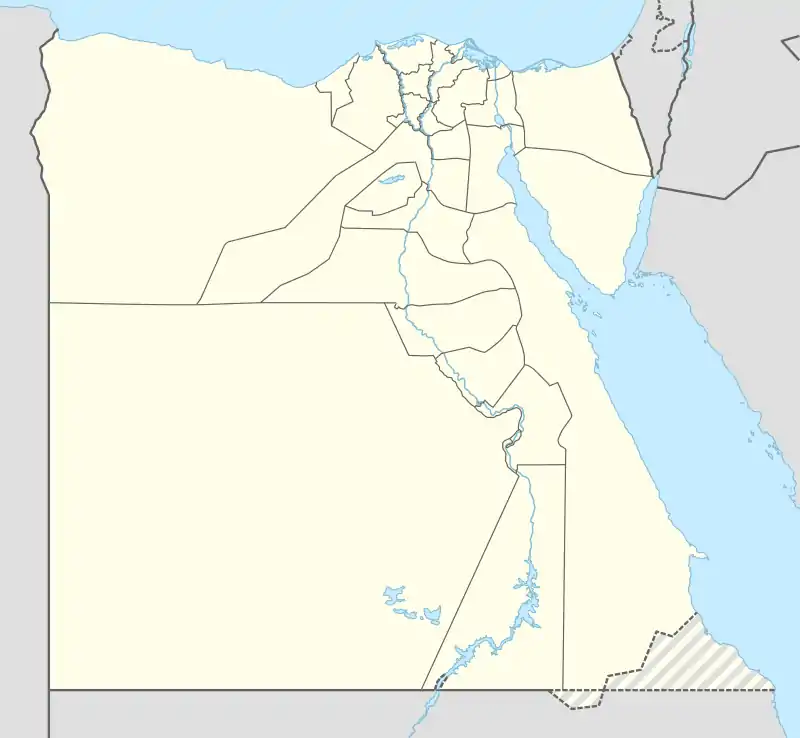Qalyub
Qalyub
قليوب ⲕⲁⲗⲓⲱⲡⲉ | |
|---|---|
 Qalyub Location in Egypt | |
| Coordinates: 30°11′59″N 31°12′19″E | |
| Country | |
| Governorate | Qalyubia |
| Area | |
| • Total | 8.27 sq mi (21.43 km2) |
| Elevation | 72 ft (22 m) |
| Population (2021)[1] | |
| • Total | 156,363 |
| • Density | 19,000/sq mi (7,300/km2) |
| Time zone | UTC+2 (EST) |
| • Summer (DST) | +3 |
Qalyub (Egyptian Arabic: قليوب pronounced [ʔælˈjuːb]; Coptic: ⲕⲁⲗⲓⲱⲡⲉ[2]) is a city containing a rural markaz, and an urban one.[3] It is located in the Qalyubia Governorate of Egypt, in the northern part of the Cairo metropolitan area, at the start of the Nile Delta. In 1986, it had a population of 84,413 inhabitants, which grew to 106,804 residents by 2006, a more than average growth.[4]
Name
The name of the city comes from a Greek personal name Calliope (Ancient Greek: Καλλιόπη).[2][5] Calliope is an ancient Greek goddess, the Muse of epic poetry.[5]
Overview
Qalyub is the commercial center for a significant agricultural region, and some records indicate that Qalyub has had a farmer's market, regularly, for close to one thousand years.[6]
The people of Qalyub have often proven to be self-reliant like in 1905 when they built their own 500-bed hospital with no help from the state.[7] Years later, the community received money from USAID for the hospital and the school, however, as in many rural villages, the Ministry of Social Affairs angered residents for not doing enough for them.[7] In 1982, the Basic Village Service Program (BVS), under the auspices of USAID, had twenty-five water projects slated for Qalyub.[8]
On February 13, 2005, Qalyub was the location of a politically significant strike over the benefits and the privatization of the Qalyub Spinning Company.[9]
Qalyub was the site of the Qalyoub train collision in August 2006.[10]
Tuk-tuks, small cars, with government-issued license plates, can be seen in modern-day Qalyub as the district has seen a more than average increase in population growth.[4]
Other
The Qalyub orthonairovirus is a member of the Bunyaviridae group of vertebrate-infecting viruses and was named after the town.[11]
References
- "Qalyūb (Kism (fully urban), Egypt) - Population Statistics, Charts, Map and Location". www.citypopulation.de. Retrieved 17 June 2023.
- Carsten Peust (2010). Die Toponyme vorarabischen Ursprungs im modernen Ägypten. p.71
- Law, Gwillim (November 23, 1999). Administrative Subdivisions of Countries: A Comprehensive World Reference, 1900 Through 1998. McFarland. ISBN 978-0-7864-6097-7. Retrieved 19 October 2016.
- Sims, David (2012). Understanding Cairo: The Logic of a City Out of Control. Oxford University Press. ISBN 9789774165535. Retrieved 22 November 2016.
- "Calliope | Greek Muse". Encyclopedia Britannica. Retrieved 2021-06-15.
- Hopkins, Nicholas S.; Westergaard, Kirsten (1998). Directions of Change in Rural Egypt. American Univ in Cairo Press. ISBN 9789774244834. Retrieved 22 November 2016.
- Sullivan, Denis Joseph (1994). Private Voluntary Organizations in Egypt: Islamic Development, Private Initiative, and State Control. ISBN 9780813012902. Retrieved 22 November 2016.
- "Egypt: The Basic Village Services Program" (PDF). USAID. Archived (PDF) from the original on 19 October 2016. Retrieved 19 October 2016.
- Sowers, Jeannie (January 5, 2012). The Journey to Tahrir: Revolution, Protest, and Social Change in Egypt. Verso Books. ISBN 9781844678754.
- El Gundy, Zeinab; Abdel-Baky, Mohamed (January 15, 2013). "Deadly train accidents in Egypt: A Timeline (1992 - 2012)". ahram online. Archived from the original on 7 November 2016. Retrieved 22 November 2016.
- Mahy, Brian W.J. (February 26, 2009). The Dictionary of Virology. Academic Press. p. 392. ISBN 9780080920368. Retrieved 21 November 2016.